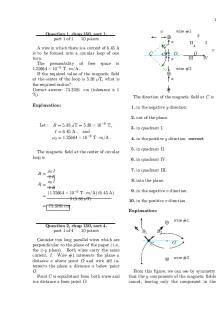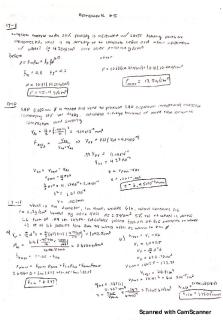Unit 5 - Mitochondria and Chloroplast Homework PDF

| Title | Unit 5 - Mitochondria and Chloroplast Homework |
|---|---|
| Author | Jessica Anne Johnson |
| Course | Cell and Molecular Biology |
| Institution | Oregon State University |
| Pages | 2 |
| File Size | 126.5 KB |
| File Type | |
| Total Downloads | 47 |
| Total Views | 145 |
Summary
BB 314...
Description
1
Unit 5 Worksheet
Part 1- Protein Import (Based on Problem 5.1.2) Chloroplasts, mitochondria, and nuclei are three intracellular organelles that are surrounded by two biological membranes. Although they possess some structural similarities, they have many differences in function and biogenesis. For statements 1 to 10 in the table, indicate whether it applies to: A. Nuclei only B. Mitochondria only C. Chloroplast only D. All three organelles E. Both chloroplasts and mitochondria, but not nuclei Statement
A-E
1) Contains an additional internal membrane system in addition to multiple membranes surrounding the organelle 2) The outer envelope membrane, but not the inner envelope membrane, is porous and allows molecules to diffuse across freely 3) mRNA is transported through multi-protein complexes in the membranes surrounding the organelle to the cytoplasm for translation 4) Contains remnant genomes carried on circular chromosomes, which reflect the evolutionary origins of the organelle 5) Contains euchromatin and heterchromatin
C
6) The inner envelope membrane is highly folded increasing its surface area
B
7) The outer envelope membrane in continuous with the endoplasmic reticulum
A
8) ATP cannot be transported across the envelope membrane out to the rest of the cell
C
9) Contains DNA
D
10) Contains ribosomes
Epro
E A E A
Part 2: Relate Structure/Function Each organelle in the cell is a unique microenvironment where certain cellular functions are performed. It can be said that the intracellular areas of low pH are essential to the function of some organelles. a) Explain how where regions of low pH reside in mitochondria and chloroplasts. Chloroplasts: the thylakoid membrane is the site of ETC and the ATP synthase. The protons are pumped into the thylakoid lumen. The pH in that compartment lowers significantly, compared to the stroma. The thylakoid membrane is highly permeable to magnesium and calcium ions, which effectively destroys the electrical component of this gradient. All the energy stored in this gradient comes from the difference in concentration of protons across this membrane. Mitochondria: The intermembrane space will have the highest proton concentration. The gradient is produced by pumping the protons out off the organelle, so the matrix pH goes up. The exterior membrane is porous and the pH of the exterior does not change much. The protons will flow through the porins over time. The potential energy stored in that gradient comes in part from the chemical differential, but more of it comes from the electrical difference across the membrane. Page 1 of 2
2
Unit 5 Worksheet
b) What is the main function of each organelle? Chloroplasts: photosynthesis, where light energy is captured and used to transform CO2 into carbohydrates. It produces almost all of the amino acids for the plant cell (except for cysteine and methionine). It produces the purines and pyrimidines used to produce nucleic acids. It is involved in the production of complex lipids. It is involved in the production of stress response chemicals that are involved in triggering the plant immune response. Mitochondria: Production of ATP for the rest of the cell, storage site for calcium ions, generation of heat, and synthesis of steroids.
c) Explain how these regions contribute to the overall function of the organelle. Chloroplasts: The electron transport chain and the ATP synthase are membrane bound, and pump protons back and forth across the thylakoid membrane.
Mitochondria: ATP production occurs in the matrix. The gradient is formed across the inner membrane, as the proteins that do the work transfer the proton from one side to the other of the inner membrane/cristae.
d) Any other organelles we have learned about so far where low pH is required for the function of the organelle? Name it here and how low pH contributes. Lysosomes: The low pH of the lysosome is maintained by membrane proteins that pump protons form the cytosol into the lysosome. This prevents lysosomes from accidentally degrading the macromolecules in the cytosol.
Page 2 of 2...
Similar Free PDFs

Unit 5 Homework
- 3 Pages

Mitochondria
- 6 Pages

Mitochondria part 1
- 6 Pages

Unit 3 homework - unit 3
- 4 Pages

Homework 5
- 2 Pages

Homework 5
- 9 Pages

Homework 5
- 4 Pages

Hoework 5 - homework 5
- 3 Pages

Homework 5
- 2 Pages

Unit 7 Homework- Chatterley
- 3 Pages

Unit 5.training and development
- 15 Pages

Unit 5 choices and actions
- 3 Pages

Unit 7 homework
- 7 Pages
Popular Institutions
- Tinajero National High School - Annex
- Politeknik Caltex Riau
- Yokohama City University
- SGT University
- University of Al-Qadisiyah
- Divine Word College of Vigan
- Techniek College Rotterdam
- Universidade de Santiago
- Universiti Teknologi MARA Cawangan Johor Kampus Pasir Gudang
- Poltekkes Kemenkes Yogyakarta
- Baguio City National High School
- Colegio san marcos
- preparatoria uno
- Centro de Bachillerato Tecnológico Industrial y de Servicios No. 107
- Dalian Maritime University
- Quang Trung Secondary School
- Colegio Tecnológico en Informática
- Corporación Regional de Educación Superior
- Grupo CEDVA
- Dar Al Uloom University
- Centro de Estudios Preuniversitarios de la Universidad Nacional de Ingeniería
- 上智大学
- Aakash International School, Nuna Majara
- San Felipe Neri Catholic School
- Kang Chiao International School - New Taipei City
- Misamis Occidental National High School
- Institución Educativa Escuela Normal Juan Ladrilleros
- Kolehiyo ng Pantukan
- Batanes State College
- Instituto Continental
- Sekolah Menengah Kejuruan Kesehatan Kaltara (Tarakan)
- Colegio de La Inmaculada Concepcion - Cebu


